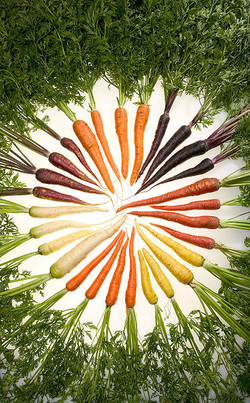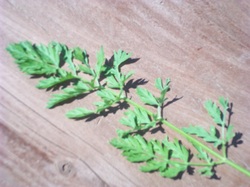According to what I found from several sources online, the tops are edible. I guess we don’t eat them much because we store carrots without their leaves, which are much more perishable. As with almost any other food, keep in mind that you may personally be allergic to them; this may show up as photodermatitis (skin becomes red or irritated when exposed to light). If you grow them yourself, you probably don’t have any pesticides to worry about eating; wash store-bought tops thoroughly.
One carrot farmer says he thinks the flavor and bitterness of the tops nicely balance the sweetness of the roots.
They’re said to be high in Vitamin K, as well as chlorophyll (obviously, since they’re green)
Vitamin K is a fat-soluble vitamin (you need to eat fat at the same meal- or with it- to access the vitamin) and is important in blood coagulation (forming scabs and avoiding hemorrhaging, including heavy menstrual bleeding) and bone growth and maintenance, as well as other helpful actions.
Chlorophyll appears to fight the growth of tumors, as well being as a good cleanser for lymph nodes, adrenal glands, and for purifying blood.
One article I found says a tea made of carrot tops is good for getting rid of intestinal worms or parasites, and juiced tops are antiseptic, good for mouthwash. Mashed tops, or the carrots themselves, can be mixed with honey and applied to festering wounds.
To eat carrot tops, try them:
- as a substitute for parsley in any recipe
-added to a green salad
-chopped and cooked with other vegetables or rice dishes
-added to a ‘green drink’ or smoothie- though go easy on this
-as the base for a pesto (add some honey to balance the bitterness), or sautéed with bacon and garlic
Extra tidbits about carrots (the roots):
-The Dutch grew carrots specifically to feed to their dairy cows. The country became famous for having the richest yellow butter as a result.
-Carrots have only been well-known in the USA since about the time of WWI.
-Carrots have the second-highest natural sugars of any vegetable, at 7% sugar. Beets score #1.
-Carrots were included in puddings and cakes in the 1600-1800’s to sweeten them.
-Carrot tops were a fashionable hat decoration in the 1600’s, used as feathers were. I love carrot greens and carrot flowers in arrangements in a vase, too.
-Many of the carrot’s minerals and nutrients are found in or just under the skin. In other words, they’re more nutritious if you don’t peel them.
And that bit you’ve heard about the Vitamin A in carrots improving your eyesight? My husband munches on carrots at work every day. Last time he went to the optometrist, he discovered his eyesight had gone from 20/30 to 20/20. Like everything else, though, don’t overdo it. Too much of anything can cause problems.
So, eat those carrots. The tops, too!
For more information, see carrotmuseum.com,
http://www.carrotmuseum.co.uk/carrotops.html,
wikipedia,
http://www.vegparadise.com/highestperch412.html
To read more about alkaloids and toxins in 'normal' foods:
http://en.wikipedia.org/wiki/Alkaloid
Natural Food Toxins
Natural Toxins in Raw Food and How Cooking Affects Them


 RSS Feed
RSS Feed